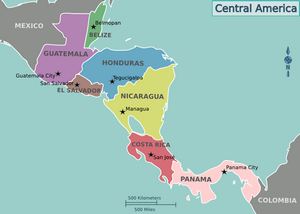Human smugglingLucrative human smuggling business via Central America benefits many
A new report estimates that the smuggling of unlawful migrants from the Northern Triangle region of Central America—Guatemala, Honduras, and El Salvador—to the United States generated between $200 million and $2.3 billion for human smugglers in 2017.

The majority of illegal border-crossers are from the Central America Nothern triangle // Source: commons.wikimedia.org
A new report estimates that the smuggling of unlawful migrants from the Northern Triangle region of Central America—Guatemala, Honduras, and El Salvador—to the United States generated between $200 million and $2.3 billion for human smugglers in 2017. The wide range reflects uncertainty about the number of migrants that travel northward, their use of smugglers and the fees they pay.
What is more, transnational criminal organizations (TCOs) are not the only, or even the main, actors, along these routes, according to the report undertaken by the Homeland Security Operational Analysis Center (HSOAC), operated by the RAND Corporation on behalf of the U.S. Department of Homeland Security.
“We learned that human smuggling involves many different types of actors and that we could not credibly distinguish most criminal organizations’ activities and revenues from those of other actors, including ad hoc groups and independent operators, that engage in human smuggling,” said Victoria Greenfield, lead author on the report and a senior economist at nonprofit, nonpartisan RAND. “At best, we could provide a broad range for the revenues to all types of human smugglers.”
RAND notes that unlawful migrants from Central America apprehended at the U.S.-Mexico border often hire smugglers for assistance or pay others at some point during their journey north. Policymakers face concerns that a substantial share of migrants’ expenditures on smuggling services could be flowing to TCOs, self-perpetuating criminal entities that challenge the rule of law and represent a potential threat to homeland security. RAND’s analysis suggests that human smuggling involves many other types of actors that often operate independently or as part of ad hoc groups.
The report also finds that drug-trafficking TCOs collect taxes, or pisos, from migrants who pass through their territories—ranging from an estimate $30 million to $180 million in 2017—and might benefit from their transit in other ways. These TCOs may also coordinate migrants’ border crossings to divert attention from other illicit activities, and they recruit or coerce some migrants to carry drugs.
“Providing the Department of Homeland Security with a better understanding of how TCOs and other actors that participate in human smuggling are structured, do business, and are financed could help inform efforts to investigate and disrupt them and to make better decisions about how to allocate resources to those efforts,” said Blas Nuñez-Neto, a co-author and senior policy researcher at RAND. “These insights could help DHS identify TCOs’ vulnerabilities and supply evidence to weigh the benefits of action.”
—Read more in Victoria A. Greenfield et al., Human Smuggling and Associated Revenues: What Do or Can We Know About Routes from Central America to the United States?(RAND, 2019)
